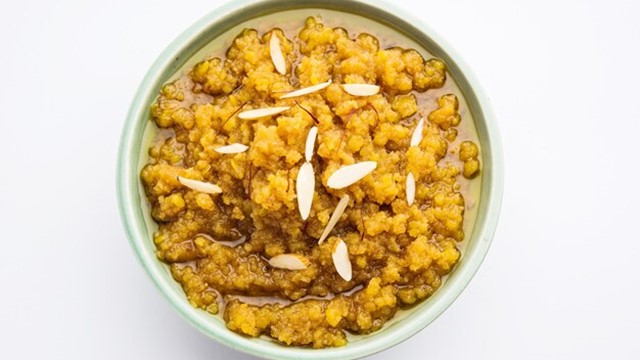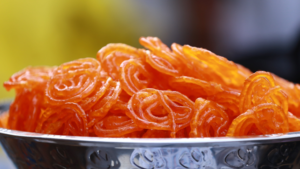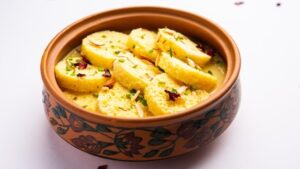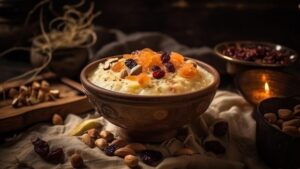Sheera, also known as Sooji Halwa or Semolina Halwa, is a popular Indian dessert that is rich, sweet, and flavored with ghee (clarified butter), semolina (sooji/rava), sugar, and often garnished with nuts and dried fruits. It holds a significant place in Indian cuisine and is prepared in various regions with slight variations in ingredients and techniques.
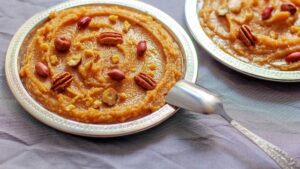
Culinary Significance:
The culinary significance of Sheera (Sooji Halwa) encompasses various cultural, traditional, and emotional aspects within Indian cuisine:
Ritual and Religious Importance:
Sacred Offerings:
Religious Significance:
Sheera holds a revered place in religious rituals, being offered as Prasad (sacred offering) in temples and during religious ceremonies, symbolizing devotion and blessings.
Festive Celebrations:
- Festive Traditions: Prepared and shared during religious festivals like Navratri, Diwali, or Janmashtami, it signifies sweetness and prosperity, often serving as a special treat during auspicious occasions.
Culinary Heritage:
Culinary Legacy:
- Generational Recipes: Recipes for sheera are often passed down through families, preserving culinary traditions and familial legacies, creating a connection to ancestral cooking methods.
Emotional and Cultural Significance:
Comforting Nostalgia:
- Comfort Food: Sheera evokes feelings of comfort, warmth, and nostalgia, reminiscent of homemade desserts that evoke fond memories and a sense of home.
Generosity and Sharing:
- Symbol of Generosity: Its preparation in larger quantities and sharing with family, friends, and guests symbolizes hospitality, generosity, and togetherness.
Versatility and Adaptability:
Culinary Adaptations:
- Adaptability: Sheera’s recipe allows for variations with added ingredients like fruits, nuts, or flavors, showcasing regional diversity and individual preferences.
Culinary Craftsmanship:
Cooking Technique:
- Skillful Preparation: The art of roasting semolina in ghee to achieve the perfect golden hue and granular texture requires patience and culinary finesse.
Festive and Social Symbolism:
Symbol of Celebration:
- Joyful Occasions: Served during celebrations and special occasions, it represents the sweetness and joy associated with communal gatherings and festivities.
Traditional Associations:
Cultural Representation:
- Cultural Identity: Sheera stands as a representation of Indian culinary heritage, showcasing the rich tapestry of flavors and customs within the country’s diverse regions.
Sheera’s significance extends beyond its delicious taste; it embodies cultural traditions, religious reverence, and shared moments of joy, bonding families and communities over its comforting and celebratory essence.
Versatile Variations
Sheera (Sooji Halwa) offers versatile variations across different regions and personal preferences. Here are some notable variations:
Ingredient Variations:
Fruit Infusions:
Banana Sheera
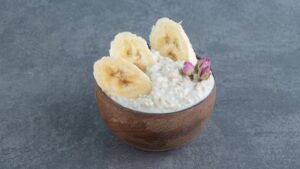
Mashed ripe bananas added to the preparation for a fruity twist, providing natural sweetness and a creamy texture.
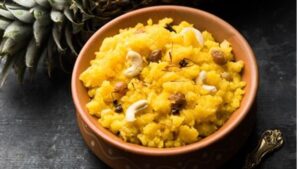
Pineapple Sheera:
Incorporating pineapple chunks into the dessert, adding a tangy and tropical flavor to the traditional recipe.
Coconut Additions:
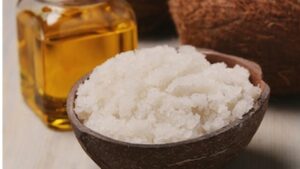
Coconut Sheera:
Grated coconut or coconut milk used in the preparation, offering a delightful coconutty aroma and a hint of tropical taste.
Seasonal Fruit Enhancements:
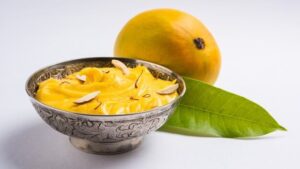
Mango Sheera:
Diced or pureed mangoes added during the cooking process, infusing the dessert with the delightful essence of mangoes when they’re in season.
Flavor and Nut Variations:
Aromatic Spices:
- Saffron-Infused Sheera: Adding saffron strands steeped in warm milk or water, lending a beautiful golden color and a subtle aroma to the dessert.
Nutty Crunch:
- Mixed Nut Sheera: Combining a variety of nuts like almonds, cashews, pistachios, and raisins for a medley of textures and flavors.
Regional Varieties:
Geographical Influences:
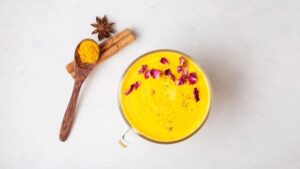
Kesari Bath:
A South Indian version, similar to Sheera, known for its use of saffron and roasted cashews, often served as a sweet in South Indian cuisine.North Indian Variants: Various regions in North India may have distinct approaches to the classic Sheera, with slight variations in ingredients and proportions.
Modern and Healthier Twists:
Alternative Sweeteners:
- Jaggery-Based Sheera: Substituting sugar with jaggery, imparting a unique caramel-like flavor and adding a touch of richness.
Dietary Modifications:
- Vegan Sheera: Using plant-based alternatives like coconut oil or vegan butter instead of ghee and almond or coconut milk instead of dairy milk for a vegan-friendly version.
Creative Fusion:
Culinary Innovations:
- Fusion Desserts: Incorporating Sheera into innovative desserts like Sheera cakes, truffles, or as a filling in pastries or crepes, blending traditional flavors with modern culinary trends.
Sheera’s versatility allows for a myriad of adaptations, accommodating regional influences, dietary preferences, and creative culinary explorations, ensuring there’s a variation to suit various tastes and occasions.
Emotional Connections:
Sheera (Sooji Halwa) holds strong emotional connections, resonating with individuals on various levels, fostering sentiments of nostalgia, comfort, and familial bonds:
Nostalgia and Comfort:
Childhood Memories:
- Home-Cooked Delight: It often evokes memories of homemade desserts cooked by mothers or grandmothers, creating a sense of nostalgia and warmth.
Comfort Food:
- Soothing Comfort: Its comforting aroma and taste offer solace during times of stress or when seeking familiarity, reminiscent of cozy and reassuring moments.
Familial and Generational Bonds:
Generational Recipes:
- Legacy of Tradition: Passed down through generations, family recipes of sheera carry stories, traditions, and the essence of culinary heritage.
Bonding Moments:
- Family Time: Preparation and sharing of sheera with family members create moments of togetherness, fostering connections and shared experiences.
Cultural Significance:
Festive Associations:
- Festival Symbolism: Often prepared and shared during religious celebrations and festivals, signifying joy, auspiciousness, and communal harmony.
Ritual Offerings:
- Sacred Significance: As Prasad (offering), it symbolizes devotion, blessings, and acts as a connector between spirituality and culinary practices.
Emotional Comfort:
Sign of Affection:
- Gestures of Love: Offering sheera to guests or loved ones reflects warmth, hospitality, and caring sentiments.
Comforting Gestures:
- Remedy for Grief: Its preparation or sharing during times of mourning or sorrow offers emotional support and solace.
Sentimental Value:
Personalized Touch:
- Memorable Experiences: Personalized variations or recipes carry sentimental value, holding cherished memories and unique culinary experiences.
Expression of Love:
- Homemade Gesture: Its preparation for special occasions or unexpected moments expresses love, care, and thoughtfulness.
Cultural Identity:
Heritage and Identity:
- Cultural Emblem: It represents a cultural identity, encapsulating the richness and diversity of Indian culinary heritage and regional flavors.
Shared Traditions:
- Common Bonds: Sheera fosters a sense of shared culture, bonding people through the enjoyment of a beloved dessert across various communities.
Sheera goes beyond being a dessert; it becomes a medium for creating connections, preserving traditions, and eliciting feelings of comfort, joy, and cherished memories, intertwining emotions with culinary experiences.
Quick and Simple Indulgence:
Sheera (Sooji Halwa) offers a delightful and quick indulgence due to its simplicity in preparation, making it an ideal dessert for various occasions or sudden cravings:
Ease of Preparation:
Short Cooking Time:
- Efficient Recipe: Sheera’s straightforward cooking process involves minimal ingredients and can be prepared relatively quickly compared to more elaborate desserts.
Common Kitchen Staples:
- Basic Ingredients: It requires simple pantry staples like semolina, sugar, ghee, and nuts, usually readily available in most households.
Instant Gratification:
Immediate Satisfaction:
- Quick Fix Dessert: Its speedy preparation allows for the instant gratification of sweet cravings or surprise dessert needs.
Last-Minute Treats:
- Impromptu Delight: Easily whipped up for unexpected guests or as a rapid dessert option for dinner parties or gatherings.
Customizable and Adaptable:
Personalized Touch:
- Versatile Recipe: Adaptable to personal preferences by adjusting sweetness levels, adding favorite fruits, or incorporating unique flavors.
Dietary Modifications:
- Flexible for Dietary Needs: Can be adapted for vegan, gluten-free, or healthier versions by altering ingredients without compromising taste significantly.
Instant Comfort:
Immediate Comfort Food:
- Instant Comfort: Its warm, aromatic essence and soothing taste provide instant comfort, ideal for cozy evenings or cold weather cravings.
Quick Reward:
- Effortless Enjoyment: Offers the satisfaction of a homemade treat without the need for extensive cooking or preparation time.
Impromptu Dessert Options:
Unexpected Treats:
- Spontaneous Dessert: Its simplicity allows for on-the-spot dessert planning without requiring extensive pre-planning or preparation.
Easy-to-please Dessert:
- Universal Appeal: Loved by people of all ages, making it a reliable dessert option for pleasing diverse palates and preferences.
Culinary Creativity:
Creative Explorations:
- Experimentation-friendly: Its basic recipe structure invites culinary experimentation, encouraging creativity and innovation.
Fusion Possibilities:
- Blend with Modern Trends: Can be transformed into innovative fusion desserts or incorporated into contemporary recipes for a trendy twist.
Sheera’s quick preparation, adaptability, and instant gratification make it an accessible and convenient dessert option, offering a delightful treat for spontaneous cravings or impromptu celebrations without compromising on its delicious taste and comforting appeal.
Recipe
Here’s a classic recipe for Sheera (Sooji Halwa):
Ingredients:
- 1 cup fine semolina (sooji/rava)
- 1/2 cup ghee (clarified butter)
- 1 cup sugar (adjust to taste)
- 2 cups water
- 1/2 teaspoon cardamom powder
- A handful of chopped nuts (almonds, cashews, pistachios)
- Raisins for garnish (optional)
Instructions:
- Preparation:
- Heat a heavy-bottomed pan or skillet over medium-low heat.
- Roasting Semolina:
- Add the semolina to the heated pan and dry roast it, stirring continuously, until it turns golden brown and emits a nutty aroma. This process might take around 6-8 minutes. Ensure the heat is kept low to prevent burning.
- Adding Ghee:
- Add the ghee to the roasted semolina and mix well. Stir and cook for another 2-3 minutes.
- Boiling Water:
- In a separate saucepan, bring water to a boil.
- Combining Ingredients:
- Carefully pour the boiling water into the semolina-ghee mixture, stirring continuously to avoid lumps. Be cautious as the mixture might splutter initially.
- Sweetening the Mixture:
- Add sugar to the mixture and stir well until the sugar dissolves completely. Adjust the sweetness according to your preference.
- Flavor Enhancement:
- Sprinkle cardamom powder into the mixture and combine it thoroughly, allowing the flavors to infuse.
- Garnishing:
- In a small pan, heat a tablespoon of ghee and lightly fry the chopped nuts until they turn golden. Add these fried nuts along with raisins to the sheera and mix well.
- Cooking Until Thickened:
- Cook the mixture on low heat, stirring continuously, until it thickens to a pudding-like consistency and the ghee starts separating from the sides. This might take around 5-7 minutes.
- Serve Warm:
- Once done, turn off the heat and serve the sheera warm.
Enjoy the Deliciousness of Homemade Sheera!
This traditional recipe for Sheera yields a lusciously sweet and aromatic dessert, featuring the nutty flavor of roasted semolina, the richness of ghee, and the delightful essence of cardamom and nuts. Adjust the sweetness and garnishes to suit your taste preferences for a comforting and indulgent homemade treat!

